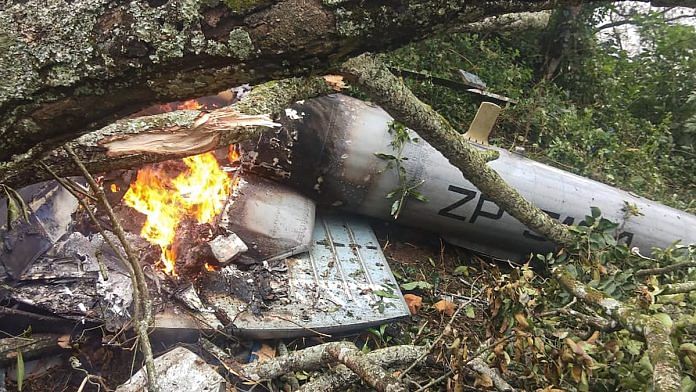The Mi-17 V5 helicopter accident in which India lost its first Chief of Defence Staff, Gen. Bipin Rawat, his wife and 11 other personnel is a tragedy that would count among the worst to befall the armed forces of any nation; one doesn’t lose one’s top military official this way. But, accidents do happen and if one were to think back to accidents of similar gravity then two come to mind. The first was the Tu‑124 aircraft crash at Jorhat on 4 November 1977 in which then-Prime Minister Morarji Desai was travelling. The five aircrew in the cockpit section died while the prime minister came out unscathed and walked to the nearest village from where he was picked up; God was working overtime that day. The second, not so fortunate – on 22 November 1963, a Chetak helicopter crashed near Poonch and we lost two Lt Generals, One Major General and an Air Vice Marshal, besides the pilot. This terrible loss of the top brass was to be headline news on all papers, but at midnight that night John Kennedy was assassinated; as reports go, all editors worked through the night to modify their lead stories due to these two ‘accidents.’
The ‘Swiss cheese model’ has been used to explain why accidents happen. Any system consists of a number of layers/domains, with some imperfections being part of their make-up. If these layers are taken to be slices of a block of Swiss cheese, then the holes in them represent imperfections. In normal times the imperfections nullify each other but if the holes get aligned (meaning imperfections come into play together) then a hazard has a path to pass through resulting in an accident. Besides human error and technical issues, accident investigators also look into systemic and organisational flaws that could be contributory causes of an accident. The investigation report brings out why an accident happened and suggests measures or steps to be taken to avoid a recurrence. Let’s look at three examples of recommendations that have found their way into normal operations post an accident(s); I must add that these are just simple representatives of the many that are taken.
Administrative
It may seem trivial, but a survey of accidents over a period of time found that quite a few were happening in early morning sorties or during those just prior to mealtimes. A deeper study indicated that aircrew involved had not had proper nourishment prior to their missions resulting in lowered blood sugar levels causing impairment in their flying ability – slower responses, lack of judgement affecting clarity of thought, etc. The result was the compulsory setting up of aircrew cafeteria in all flight complexes and institution of aircrew rations. I remember that in Air Force Academy in 1976, when we were fight cadets, and aircrew rations had not been introduced, our breakfast was brought from the cadets’ mess and we compulsorily had to have porridge and a bite before getting airborne; in fact, our instructors asking us whether we had eaten something was a ritual before every sortie and one I continued when I became an instructor myself.
Also read: CDS Gen Bipin Rawat, wife, 11 others die in IAF chopper crash in Tamil Nadu
Operational
A break in flying results in a reduction of flying adeptness in some. When this was noticed in a few accidents, limits of ‘break in flying’ were laid down after which a pilot would mandatorily have to fly a check sortie with an instructor before flying as captain.
After the 22 November 1963 Poonch accident, orders came into force that two Generals will not fly in the same helicopter.
Sometimes design characteristics result in requirement of corrective actions being introduced. The ALH Dhruv has rigid rotors that have an inherent characteristic of ‘retreating blade stall’ (causing the helicopter to spiral down) if the aircraft is rolled fast beyond a certain rate and bank angle. After this was found to be a cause in a few accidents, restrictions were introduced in manoeuvring of the helicopter; if one sees the crisp and sharp manoeuvring of IAF’s Sarang aerobatic team in yesteryear videos and compares them with the latest ones, one can spot the difference. Similarly, two aircraft of the Suryakiran aerobatic team had a mid-air collision in a manoeuvre that had an inverted aircraft flying over another aircraft flying straight and level; that particular item was done away for some time and has been re-introduced lately with greater distance between the two members for increased safety.
Also read: All about Mi-17V5, the helicopter that crashed with Gen. Bipin Rawat & 13 others on board
Technical
Broadly speaking, technical reasons fall under two broad sub-categories; first, human error while servicing the aircraft and second, technical defects. One of the ways of ameliorating the human error aspect is by having additional supervisory checks in the servicing schedule, while technical defects may require basic design or system changes. The most apt example is that of Boeing 737 Max, which was grounded in 2019 after two fatal losses; major software changes have been done, with fresh certifications and the 737 Max has just started re-entering service.
So, post the Coonoor crash of Gen Rawat’s helicopter what can one expect? The Court of Inquiry will go into all aspects of the mission and one is sure that its recommendations will have a far-reaching impact on VVIP operations of the IAF. That there will be a lot of soul searching is true, but what is also certain is that the IAF’s helicopter fleet will imbibe the lessons to prevent such mishaps from recurring.
The author is a veteran IAF helicopter flying instructor and an experimental test pilot. He tweets at @BahadurManmohan. Views are personal.
(Edited by Neera Majumdar)



